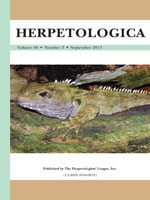Predation is a dominant and influential factor in most ecological communities. However, little is known about how the federally endangered Barton Springs Salamander, Eurycea sosorum, responds to predators. Using captive-hatched (predator-naïve) salamanders, we examined the antipredator response of E. sosorum to chemical cues from (1) native Western Mosquitofish (Gambusia affinis), (2) introduced Redbreast Sunfish (Lepomis auritus), (3) native Largemouth Bass (Micropterus salmoides), and (4) a blank water control. Salamanders decreased activity (antipredator behavior) in response to all fish treatments but not to the blank water control. There was no difference between the response to the G. affinis and L. auritus, but salamanders responded less to these treatments than to M. salmoides. The antipredator response to G. affinis may be an ontogenetic hold over as G. affinis has been found to consume amphibian larvae and eggs. In an additional study to test whether antipredator behavior was a generalized response to all fish species, we found that E. sosorum did not respond to small, nonnative, nonpredatory Guppies (Poecilia reticulata). This suggests that the observed behavior in our first experiment represents antipredator behavior specific to the species tested. Overall, these results indicate that E. sosorum has innate recognition of predatory fish, and that the stronger antipredator response to M. salmoides over the other fish species may be an outcome of risk assessment. The antipredator response to G. affinis has management implications as G. affinis is sympatric with the largest population of E. sosorum, and may be consuming both eggs and larvae of these salamanders.
How to translate text using browser tools
1 September 2013
Chemically Mediated Predator Avoidance in the Barton Springs Salamander (Eurycea sosorum)
Dominic L. DeSantis,
Drew R. Davis,
Caitlin R. Gabor
ACCESS THE FULL ARTICLE

Herpetologica
Vol. 69 • No. 3
September 2013
Vol. 69 • No. 3
September 2013
antipredator behavior
chemosensory
Gambusia affinis
Innate recognition
kairomone
predator–prey interaction




